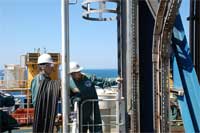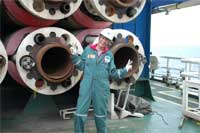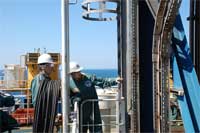 NARRAGANSETT, R.I. – November 7, 2012 – University of Rhode Island graduate student Justine Sauvage returned recently from a two-month expedition aboard a Japanese ship studying life deep beneath the seafloor.
NARRAGANSETT, R.I. – November 7, 2012 – University of Rhode Island graduate student Justine Sauvage returned recently from a two-month expedition aboard a Japanese ship studying life deep beneath the seafloor.
In the process of the research effort, the international team of scientists and crew aboard the 210-meter ship D/V Chikyu set a record for drilling farther into the sediment than any previous research ship had done before. They drilled 2,446 meters below the seafloor off the coast of Japan, while the previous record was 2,112 meters.
“There are deeply buried coal beds off the coast of Japan that are undergoing lots of transformation. They give off chemicals that might stimulate microbial life in the overlying sediment. I’m studying the limits of life in these deep sea sediments,” said Sauvage, a native of Brussels who is completing her master’s degree and will begin a doctoral program at the URI Graduate School of Oceanography next semester.
 Every day while aboard ship she collected the sediment cores from the drill team, put the sediment in a press, squeezed out the water, and analyzed the chemistry of the water. The deeper they drilled, the harder it was to squeeze out the water.
Every day while aboard ship she collected the sediment cores from the drill team, put the sediment in a press, squeezed out the water, and analyzed the chemistry of the water. The deeper they drilled, the harder it was to squeeze out the water.
“The pores in the sediment contain water, and the chemistry of the water tells us about the microbes that live down there,” Sauvage said. “It tells us what microbial processes are going on, what they are doing and eating and the chemicals they are releasing. It gives us information about their metabolic activity.
“We see life everywhere, but where are the limits of life on Earth? If we can understand all of the places where life is capable of living, then that may give us a link to finding life on other planets,” she added.
For her Ph.D., Sauvage is studying the microbial activity deep in the sediment in the South Pacific gyre, the farthest place from land on Earth, a place where very few cells live and where even less organic matter ever reaches the seafloor. The sediment there contain numerous radioactive elements, and it appears likely that the living organisms may be feeding on the hydrogen produced from the radioactive splitting of water, since little else is available to eat.
“If that kind of ‘nuclear life’ is taking place on Earth, then we can extrapolate that it may be happening in other less-hospitable environments characterized by wet sediments rich in radioactive elements, like subsurface Mars and Europa,” she said.
The expedition to the Japanese coast was Sauvage’s first experience on a research ship, and she admits to being nervous when it began. But she was also very excited about it.
“I mostly do computer modeling, so spending two months at sea playing with mud was a great opportunity,” she said with a smile. “I finally got to appreciate all of the work that goes into this kind of research.”
Sauvage also appreciated what she learned from the rest of the scientific team.
“When I wasn’t doing my own geochemistry work, I went to look at the other research that was taking place – micropaleontology, microbiology, sedimentology,” she said. “I wanted to expand my knowledge by looking at what they were doing and getting involved in all of these other fields. It gave me a really good integrated view of everything that takes place on a drilling ship.”
Her favorite moment of the expedition came when an earthquake struck nearby and the ship started shaking.
“I had never experienced an earthquake before, and because the boat was connected to the seafloor, we were worried that the equipment could be damaged and it would mess up the whole expedition,” said Sauvage. “But it didn’t.”
As she looks ahead to her future career, Sauvage acknowledges that she developed a great appreciation for the technology involved in ocean research while aboard the D/V Chikyu, and that may influence her career path.
“Maybe my next step will be to work in Japan,” she said. “I want to see something completely different. Europe and the United States are in my comfort zone, so I may want to get a little out of my comfort zone next time.”
Photos submitted by Justine Sauvage

